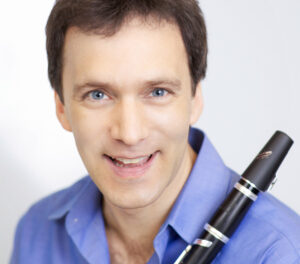Classical music aficionados all are familiar with veteran performers clarinetist Richard Stoltzman and pianist Emanuel Ax; they just don’t know them as a team. And that’s the thing that made their performance at the Duke Artists Series so novel and interesting. For Ax, this tour appears to be the first time he has paired up with a solo clarinetist, an assignment for which, according to him, he had to learn all new music. Stoltzman, in turn, was working with a new partner – if not new music – and it seems to have inspired him to take on a new style of playing and interpreting works, some of which have by now become part of his genome. Ax appeared delighted with the project, announcing that the two Brahms clarinet sonatas, heretofore unknown to him, were now his favorite Brahms pieces.
From the body language and interplay between the two artists, it is obvious that Stoltzman and Ax are pals. This fact strongly affected the performance, especially in Commedia, a 2002 composition by Yehudi Wyner (b.1929), written for Stoltzman. Although the composer’s program notes made a strange point of relating the work to Dante, Ax’s introduction from the stage characterized it as a more of the playful interchange between two figures of the Commedia dell’arte, an “in-your-face” type (Pulcinella) and a dreamy romantic (Pierrot). The work is both accessible and openly funny, beginning with the tempo marking “LABOOH” (“like a bat out of hell’). There is rapid, witty dialogue between clarinet and piano that shows off the virtuosity of both players in the “LABOOH” section. Stoltzman and Ax were constantly looking and playing at and off each other, Stoltzman finding abundant opportunity to literally turn and put his instrument practically in Ax’s face.
Even in the Wyner work, Stoltzman’s current take on interpretation is “keep it soft.” Once known for a kind of aggressive brassiness, he rarely played above forte for the entire evening, giving most everything in subtle shades of piano. Clearly he and Ax had worked this all out to perfection. Ax managed never to overpower his partner, even in the thickly textured passages of the two Brahms Clarinet Sonatas, Op.120. It was a treat to hear both sonatas on one program, especially since the artists had a deliberately novel take on the two works with their gentle and understated approach. Brahms probably would have approved, since the inspiration for the sonatas’ composition was clarinetist Richard Mühlfeld, who was known for his refined and gentle tone. The highlight was the slow movement of the Sonata No.1 which ended in a pppp that left us afraid to breathe.
Another novelty of the evening was the third movement, Largo doloroso, from the Clarinet Sonata by Thomas McKinley (b.1938), another work written for Stoltzman. The movement, unabashedly romantic, fitted well into the gentle mood of the evening. It made us wish for more, but according to Ax, he hasn’t yet learned the other three movements. We would have been happy if Stoltzman and Ax had worked out the kinks from the rest of McKinley’s work and played them, instead of opening the program with the banal and worn out Fantasy Pieces for Clarinet and Piano, Op.73 by Robert Schumann.











